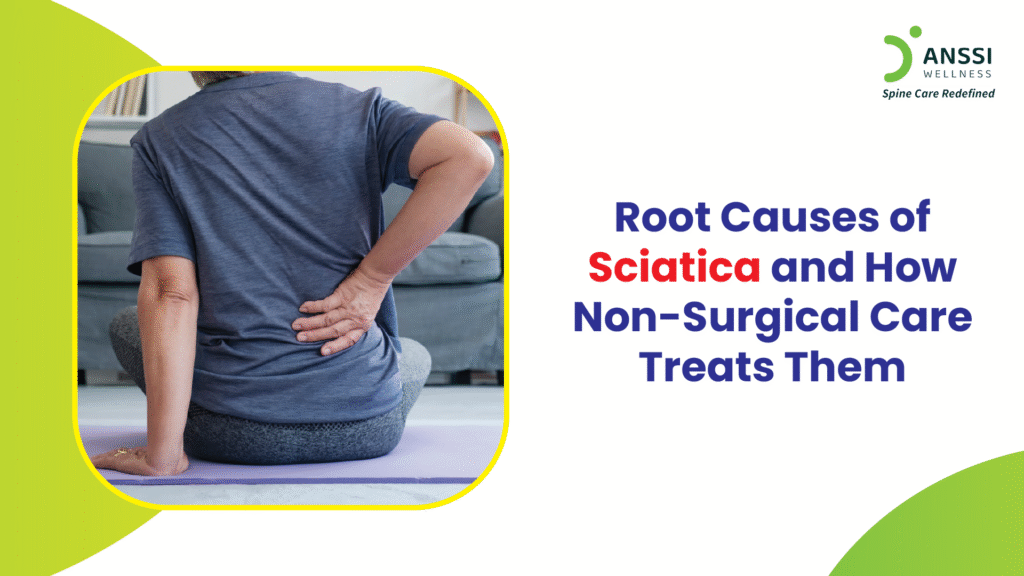Sciatica is one of the most common and painful spine-related conditions affecting adults today. It often begins as mild back pain and gradually turns into a sharp, radiating pain running down one leg. This pain can make everyday tasks like sitting, walking, or even sleeping challenging.
While many people think of sciatica simply as nerve pain, it’s actually a symptom of an underlying spinal issue that needs attention. Understanding the root causes of sciatica is the first step toward finding lasting, effective, and non-surgical relief.
Understanding Sciatica
The sciatic nerve is the longest and thickest nerve in the human body. It originates from the lower spine, passes through the hips and buttocks, and extends down each leg. When this nerve is irritated or compressed, it leads to the condition known as sciatica.
Sciatica pain is usually felt on one side of the body and can range from mild to severe. Common symptoms include sharp or shooting pain down the leg, burning sensations, tingling, numbness, or even muscle weakness. In some cases, the pain can worsen while sitting or standing for long periods.
Root Causes of Sciatica
The important thing to remember is that sciatica is not a disease itself; it’s a signal that something is wrong in the spine. Identifying and addressing its root cause can help prevent recurring pain and long-term nerve damage.
1. Herniated or Bulging Disc
This is the most frequent cause of sciatica. Spinal discs act as cushions between the vertebrae, absorbing shocks and allowing flexibility. When a disc bulges or herniates, its inner material pushes out and presses on nearby nerve roots, including the sciatic nerve. This pressure leads to inflammation, pain, and nerve irritation.
2. Spinal Stenosis
Spinal stenosis refers to the narrowing of the spinal canal, which compresses the spinal cord and nerves. This condition is often related to ageing and degenerative changes in the spine. The pressure caused by stenosis can pinch the sciatic nerve, resulting in radiating pain and stiffness in the lower back and legs.
3. Degenerative Disc Disease
As we age, spinal discs lose water content and flexibility, reducing their ability to absorb shock. This wear and tear can cause discs to thin or collapse, putting additional pressure on the nerves. Degenerative disc disease is a slow process, but it is a significant contributor to chronic sciatica in adults over 40.
4. Muscle Imbalance or Piriformis Syndrome
Not all sciatic nerve compression happens within the spine. The piriformis muscle, located in the buttock region, can tighten or spasm and put pressure on the sciatic nerve running beneath it. This is known as piriformis syndrome and often mimics traditional sciatica symptoms.
5. Poor Posture and Sedentary Lifestyle
Sitting for long hours, slouching over a desk, or improper lifting techniques can all contribute to poor spinal alignment. Over time, this increases the strain on discs and muscles, making them more susceptible to injury and nerve compression.
Non-Surgical Treatments for Sciatica
Thankfully, most cases of sciatica can be treated successfully without surgery. Non-surgical care aims to relieve pressure on the sciatic nerve, restore spinal alignment, and promote long-term healing.
Non-Surgical Spinal Decompression Treatment
This advanced, non-invasive treatment is designed to gently stretch the spine and relieve pressure from compressed discs and nerves. By creating negative pressure within the spinal discs, the decompression mechanism allows bulging or herniated discs to retract naturally.
Non-surgical spinal decompression treatment also improves the flow of oxygen, water, and nutrients to the affected areas, accelerating healing. This procedure has shown excellent results in treating chronic sciatica without the risks of surgery or medication dependency.
Physiotherapy and Stretching Exercises
A customised physiotherapy plan can strengthen the muscles that support the spine, improve flexibility, and reduce inflammation.
Specific exercises target the lower back, hips, and legs to relieve nerve compression and restore mobility. Gentle stretches, such as hamstring and piriformis stretches, can also reduce tightness around the sciatic nerve.
Posture Correction and Ergonomics
Improper sitting posture or desk setup can worsen sciatica.
Using ergonomic chairs, keeping your feet flat on the floor, and maintaining the natural curve of your spine while sitting are simple but powerful steps toward pain prevention. Small changes in daily habits can contribute significantly to reducing pressure on your lower back.
Lifestyle Modifications
Hydration, regular movement, and maintaining a healthy weight play a big role in spinal health.
- Avoid sitting continuously for long hours; take short breaks to stand, stretch, or walk.
- Proper nutrition also supports disc health. Foods rich in omega-3 fatty acids, calcium, and antioxidants can help reduce inflammation and strengthen spinal tissues.
Complementary Therapies
Other supportive therapies like ice or heat therapy, massage, and relaxation techniques can help manage pain and promote circulation. Alternating between cold and warm compresses can reduce swelling and muscle spasms effectively.
The Advantages of Non-Surgical Care
Non-surgical treatments are safe, cost-effective, and allow patients to recover naturally. Unlike surgery, which involves long recovery periods and potential complications, non-invasive solutions help restore spinal health while preserving natural body function. Most importantly, they address the underlying cause of sciatica rather than just masking symptoms.
Non-surgical spinal decompression treatment, when combined with physiotherapy and healthy lifestyle habits, offers a holistic approach to treating sciatica. It not only relieves pain but also prevents recurrence by correcting spinal misalignments.
About ANSSI:
ANSSI Wellness focuses on improving the quality of life for patients suffering from spinal issues, aiming to provide relief where other conventional treatments have failed. Through advanced Non-Surgical Spinal Decompression Treatment, ANSSI is committed to helping patients avoid surgery and recover in a safe, effective, and compassionate environment.
Connect with ANSSI Wellness on LinkedIn, Instagram, and Facebook for expert guidance.




